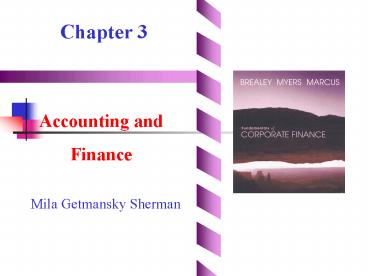The Firm and The Financial Manager - PowerPoint PPT Presentation
1 / 20
Title:
The Firm and The Financial Manager
Description:
'Profits' subtract depreciation (a non-cash expense) ... Depreciation 1,082. Changes in working capital 457. Cash Flow from operations 4,201 ... – PowerPoint PPT presentation
Number of Views:53
Avg rating:3.0/5.0
Title: The Firm and The Financial Manager
1
Chapter 3
Accounting and Finance
Mila Getmansky Sherman
2
Topics Covered
- The Balance Sheet
- The Income Statement
- The Statement of Cash Flows
- Accounting Practice Malpractice
- Taxes
3
The Balance Sheet
- Definition
- Financial statements that show the value of
the firms assets and liabilities at a particular
point in time (from an accounting perspective).
4
The Balance Sheet
The Main Balance Sheet Items
5
Market Value vs. Book Value
- Book Values are determined by GAAP
- Market Values are determined by current values
- Equity and Asset Market Values are usually
higher than their Book Values
6
Market Value vs. Book Value
- Example
- According to GAAP, your firm has equity worth 6
billion, debt worth 4 billion, assets worth 10
billion. The market values your firms 100
million shares at 75 per share and the debt at
4 billion. - Q What is the market value of your assets?
- A Since (AssetsLiabilities Equity), your
assets must have a market value of 11.5 billion.
7
Market Value vs. Book Value
- Example (continued)
- Book Value Balance Sheet
- Assets 10 bil Debt 4 bil Equity 6
bil
8
The Income Statement
- Definition
- Financial statement that shows the revenues,
expenses, and net income of a firm over a period
of time (from an accounting perspective).
9
The Income Statement
- Earnings Before Income Taxes (EBIT)
- EBIT total Revenues
- - costs
- - deprecation
10
The Income Statement
- Pepsico Income Statement (year end 2001)
- Net Sales 26,935
- COGS 10,754
- Other Expenses 392
- Selling, GA expenses 10,526
- Depreciation expense 1,082
- EBIT 4,181
- Net interest expense 152
- Taxable Income 4,029
- Income Taxes 1,367
- Net Income 2,662
11
Profits vs. Cash Flows
- Differences
- Profits record income and expenses at the time
of sales, not when the cash exchanges actually
occur cash vs. accrual accounting - Profits subtract depreciation (a non-cash
expense) - Profits ignore cash expenditures on new capital
(the expense is capitalized) - Profits do not consider changes in working
capital
12
The Statement of Cash Flows
- Definition
- Financial statement that shows the firms cash
receipts and cash payments over a period of time.
13
The Statement of Cash Flows
- Pepsico Statement of Cash Flows (excerpt - year
end 2001) - Net Income 2,662
- Non-cash expenses
- Depreciation 1,082
- Changes in working capital 457
- Cash Flow from operations 4,201
- Cash Flow from investments (2,637)
- Cash provided by financing (1,919)
- Net Change in Cash Position (355)
14
Accounting Practice
- Stock options
- Allowance for bad debts
- Revenue recognition
15
Taxes
- Taxes have a major impact on financial decisions
- Marginal Tax Rate is the tax that the individual
pays on each extra dollar of income. - Average Tax Rate is the total tax bill divided by
total income.
16
Taxes
- Example - Taxes and Cash Flows can be changed by
the use of debt. Firm A pays part of its profits
as debt interest. Firm B does not. - Firm A Firm B
- EBIT 100 100
- Interest 40 0
- Pretax Income 60 100
Example - Taxes and Cash Flows can be changed by
the use of debt. Firm A pays part of its profits
as debt interest. Firm B does not. Firm
A EBIT 100 Interest 40 Pretax Income
60 Tax (35) 21 35 Net
Income 39 65
17
Taxes
- FOOD FOR THOUGHT - If you were both the debt and
equity holders of the firm, which would generate
more cash flow to you? (assume Net Income Cash
Flow) - Firm A Firm B
- EBIT 100 100
- Interest 40 0
- Pretax Income 60 100
- Tax (35) 21 35
- Net Income 39 65
?
18
Taxes
- FOOD FOR THOUGHT - If you were both the debt and
equity holders of the firm, which would generate
more cash flow to you? (assume Net Income Cash
Flow) - Firm A Firm B
- Net Income 39 65
?
- Interest 40 0
- Net Cash Flow 79 65
19
Corporate Tax Rates (2002)
20
Personal Tax Rates (2002)































